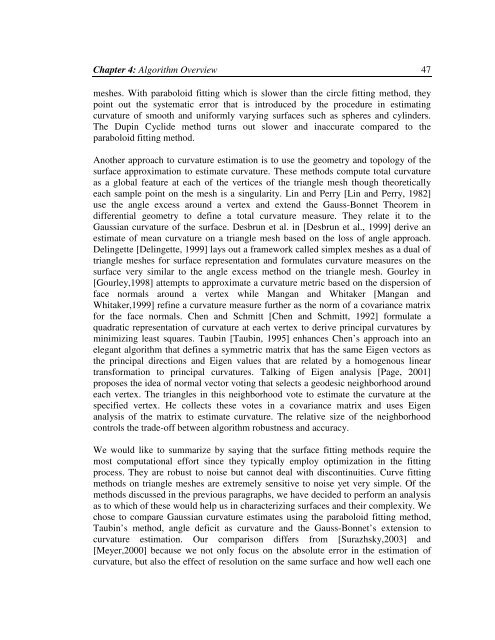To the Graduate Council: I am submitting herewith a thesis written by ...
To the Graduate Council: I am submitting herewith a thesis written by ...
To the Graduate Council: I am submitting herewith a thesis written by ...
You also want an ePaper? Increase the reach of your titles
YUMPU automatically turns print PDFs into web optimized ePapers that Google loves.
Chapter 4: Algorithm Overview 47meshes. With paraboloid fitting which is slower than <strong>the</strong> circle fitting method, <strong>the</strong>ypoint out <strong>the</strong> systematic error that is introduced <strong>by</strong> <strong>the</strong> procedure in estimatingcurvature of smooth and uniformly varying surfaces such as spheres and cylinders.The Dupin Cyclide method turns out slower and inaccurate compared to <strong>the</strong>paraboloid fitting method.Ano<strong>the</strong>r approach to curvature estimation is to use <strong>the</strong> geometry and topology of <strong>the</strong>surface approximation to estimate curvature. These methods compute total curvatureas a global feature at each of <strong>the</strong> vertices of <strong>the</strong> triangle mesh though <strong>the</strong>oreticallyeach s<strong>am</strong>ple point on <strong>the</strong> mesh is a singularity. Lin and Perry [Lin and Perry, 1982]use <strong>the</strong> angle excess around a vertex and extend <strong>the</strong> Gauss-Bonnet Theorem indifferential geometry to define a total curvature measure. They relate it to <strong>the</strong>Gaussian curvature of <strong>the</strong> surface. Desbrun et al. in [Desbrun et al., 1999] derive anestimate of mean curvature on a triangle mesh based on <strong>the</strong> loss of angle approach.Delingette [Delingette, 1999] lays out a fr<strong>am</strong>ework called simplex meshes as a dual oftriangle meshes for surface representation and formulates curvature measures on <strong>the</strong>surface very similar to <strong>the</strong> angle excess method on <strong>the</strong> triangle mesh. Gourley in[Gourley,1998] attempts to approximate a curvature metric based on <strong>the</strong> dispersion offace normals around a vertex while Mangan and Whitaker [Mangan andWhitaker,1999] refine a curvature measure fur<strong>the</strong>r as <strong>the</strong> norm of a covariance matrixfor <strong>the</strong> face normals. Chen and Schmitt [Chen and Schmitt, 1992] formulate aquadratic representation of curvature at each vertex to derive principal curvatures <strong>by</strong>minimizing least squares. Taubin [Taubin, 1995] enhances Chen’s approach into anelegant algorithm that defines a symmetric matrix that has <strong>the</strong> s<strong>am</strong>e Eigen vectors as<strong>the</strong> principal directions and Eigen values that are related <strong>by</strong> a homogenous lineartransformation to principal curvatures. Talking of Eigen analysis [Page, 2001]proposes <strong>the</strong> idea of normal vector voting that selects a geodesic neighborhood aroundeach vertex. The triangles in this neighborhood vote to estimate <strong>the</strong> curvature at <strong>the</strong>specified vertex. He collects <strong>the</strong>se votes in a covariance matrix and uses Eigenanalysis of <strong>the</strong> matrix to estimate curvature. The relative size of <strong>the</strong> neighborhoodcontrols <strong>the</strong> trade-off between algorithm robustness and accuracy.We would like to summarize <strong>by</strong> saying that <strong>the</strong> surface fitting methods require <strong>the</strong>most computational effort since <strong>the</strong>y typically employ optimization in <strong>the</strong> fittingprocess. They are robust to noise but cannot deal with discontinuities. Curve fittingmethods on triangle meshes are extremely sensitive to noise yet very simple. Of <strong>the</strong>methods discussed in <strong>the</strong> previous paragraphs, we have decided to perform an analysisas to which of <strong>the</strong>se would help us in characterizing surfaces and <strong>the</strong>ir complexity. Wechose to compare Gaussian curvature estimates using <strong>the</strong> paraboloid fitting method,Taubin’s method, angle deficit as curvature and <strong>the</strong> Gauss-Bonnet’s extension tocurvature estimation. Our comparison differs from [Surazhsky,2003] and[Meyer,2000] because we not only focus on <strong>the</strong> absolute error in <strong>the</strong> estimation ofcurvature, but also <strong>the</strong> effect of resolution on <strong>the</strong> s<strong>am</strong>e surface and how well each one
















